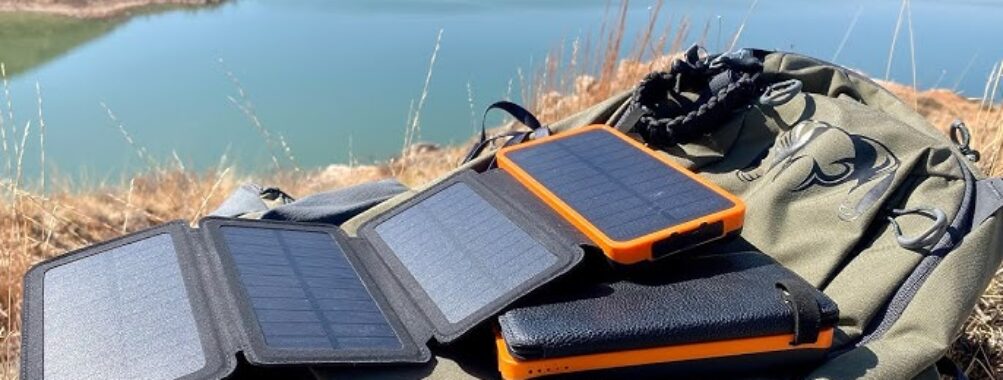
Best Solar Power Banks for Travel in 2025: Top 7 Portable Chargers for Adventurers
Solar power banks have turned into one of those essential travel gadgets you don’t want to leave behind, especially if you’re the type who’s always chasing the next adventure. I mean, who doesn’t want to keep their phone juiced up when you’re miles from the nearest plug? These little lifesavers soak up sunshine and spit out electricity, so your devices stay alive—whether you’re hiking in the backcountry or just lazing on a beach.
Unlike your standard power bank, solar chargers let you roam without worrying about the next wall outlet. They pull energy straight from the sun, and most of them still let you top up via USB if the weather turns. The top models? They blend durability, efficiency, and portability. If you travel often, you already know how important that combo is.
When you’re shopping for a solar power bank, keep an eye on battery capacity (that’s the mAh number), how fast it charges, the weight, and whether it can handle a little rain or a dunk in a puddle. Planning to charge more than one device? Multiple USB ports are a must. Not all solar panels are created equal—some convert sunlight much more efficiently than others. I put eight popular solar power banks through their paces in all sorts of travel scenarios to find the ones worth packing.
Table of Contents
- Best Solar Power Banks for Travel
- BLAVOR Portable Solar Power Bank
- Nuynix Solar Power Bank
- Mregb Solar Power Bank 42800mAh
- Hiluckey Foldable Solar Power Bank
- Nuynix Solar Power Bank 49800mAh
- Boogostore Solar Power Bank with Hand Crank
- FMOOOSTORE 49800mAh Solar Power Bank
- ERRBBIC Solar Power Bank
- Buying Guide
- Frequently Asked Questions
- What are the top-rated solar power banks for extended camping trips?
- How do solar power banks perform under different weather conditions while traveling?
- What are the key features to look for in a high-capacity solar power bank intended for travel?
- How do the charging speeds of the best solar power banks compare for travel use?
- Can I take a high-capacity solar power bank on a flight, and what are the regulations to be aware of?
- What are the benefits of using a solar power bank during travel compared to traditional power banks?
- Book Your Dream Experience
- More Travel Guides
Best Solar Power Banks for Travel
Having a solid solar power bank in your bag just makes sense if you’re heading anywhere off the beaten path or simply want the freedom to wander without dead gadgets. These portable devices soak up sun so your phone, camera, or even your e-reader keeps working long after the outlets disappear. Over the years, I’ve tested more models than I can count, from the deserts to rainy forests, to help you find a solar charger that’s actually worth your money.
BLAVOR Portable Solar Power Bank
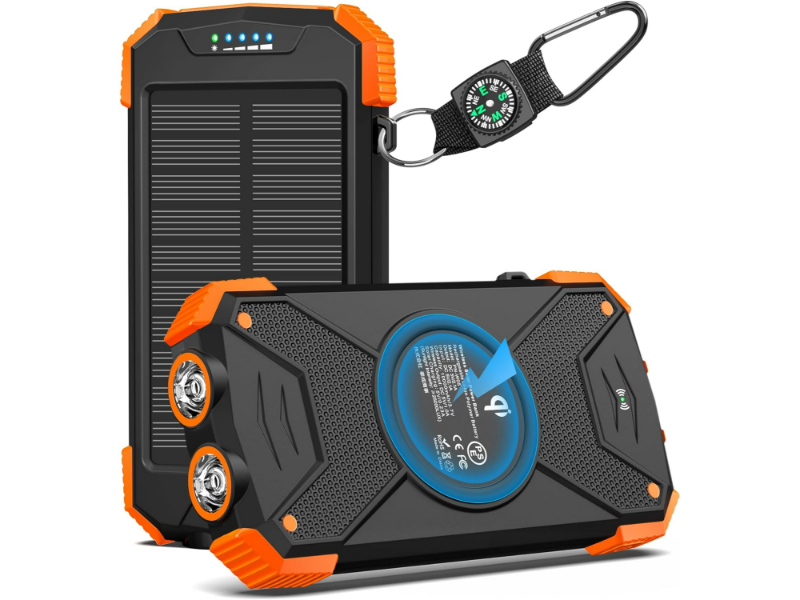
BLAVOR’s solar power bank has become my go-to travel companion for its impressive fast charging, rugged build, and a few clever extras that actually come in handy outdoors.
Pros
- 20W fast charging, plus several charging options
- Compact, tough design with IPX5 waterproofing
- Dual flashlights and a compass carabiner built in
Cons
- Solar charging works slowly—think backup, not main power
- At 9.3 ounces, it’s a bit heavier than some
- Wireless charging pad is picky about phone placement
I took this bank on a recent hiking weekend and honestly, it surprised me. The 10,000mAh battery kept my iPhone alive all weekend—no wall plug required. That USB-C fast charging? It got my phone from 20% to 85% during a lunch break, which was a lifesaver.
The rugged, orange-rubber shell feels great in your hand and shrugs off light rain. I liked not having to stress about a little drizzle or dust. The dual flashlights actually lit up my whole tent area—way better than I expected.
Solar charging does work, but don’t count on it as your main source. I left it in full sun for hours and got about a 15% boost. It’s really just for emergencies. Wireless charging is handy but a tad finicky; you’ll need to find that sweet spot. Still, this BLAVOR is now a staple in my pack for both city getaways and wild escapes.
Nuynix Solar Power Bank
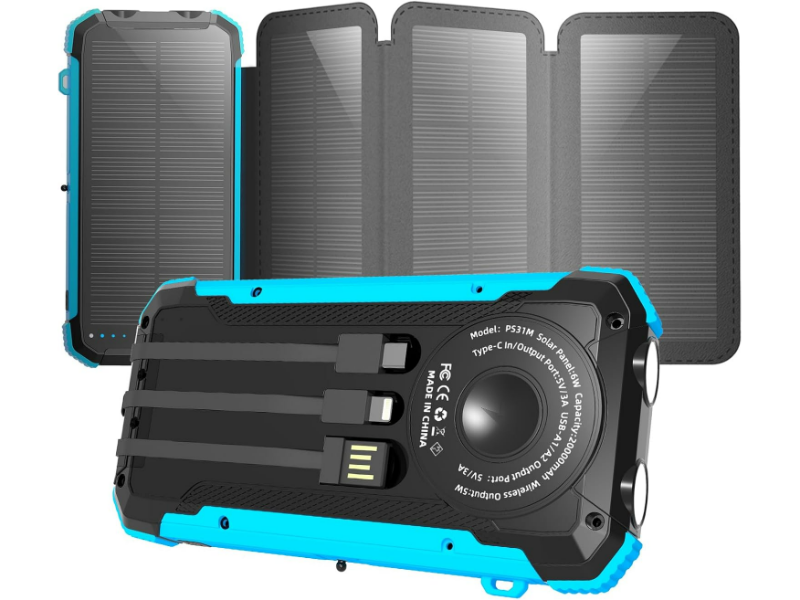
If you’re the type who wants reliable charging options even when you’re way off the grid, this rugged 20000mAh Nuynix solar power bank is a smart pick.
Pros
- Multiple ways to charge—wireless and three built-in cables
- Four solar panels, so it charges faster in the sun
- Bright LED flashlight with three emergency modes
Cons
- Just over a pound—noticeably heavier than most
- Solar charging only shines in direct sunlight
- Takes up more space than your average bank
I brought this Nuynix along on a camping trip and it quickly became my favorite travel accessory. The 20000mAh battery kept my phone, tablet, and earbuds powered the whole time.
The built-in cables are a game changer—no more digging for the right cord. Solar charging actually works decently if you leave it strapped to your pack in the sun. By lunchtime, I had enough juice for a quick phone top-up. Four panels definitely beat the single-panel banks I’ve tried.
The flashlight is no gimmick. Three modes (steady, flashing, strobe) meant I could set up camp after dark and keep track of my gear. The silicone port covers kept out dust and rain, and the whole thing feels built for adventure, not just a desk drawer.
Mregb Solar Power Bank 42800mAh
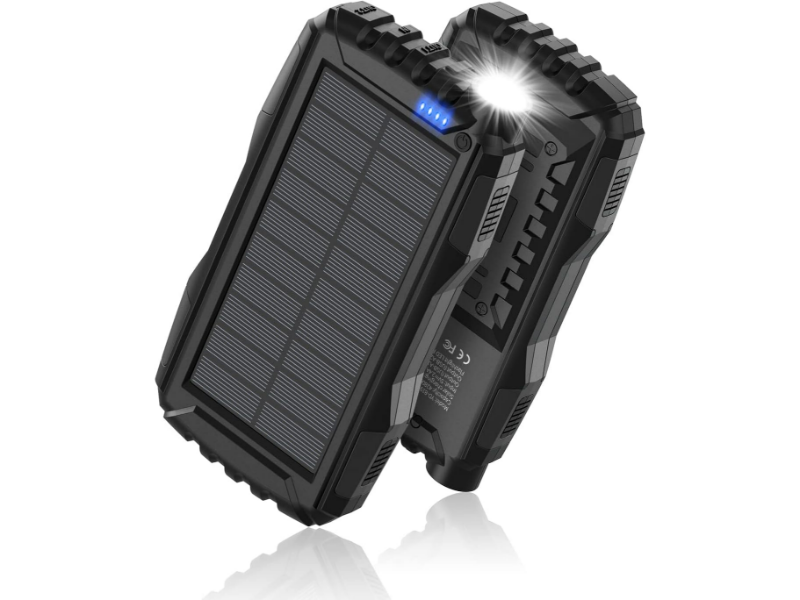
The Mregb solar power bank stands out for its massive capacity and smart emergency features. If you’re serious about your travel gear, this one’s worth considering.
Pros
- Huge 42800mAh battery—charge multiple devices, multiple times
- Rugged, waterproof build handles rough conditions
- Super bright flashlight that lasts up to 100 hours
Cons
- Weighs in at 1.34 pounds—definitely not ultralight
- Solar charging is slow (think backup only)
- Button layout can be tricky in the dark
I put this Mregb through its paces on a camping trip and, wow, the battery capacity is the real deal. I charged my phone four times, my tablet once, and still had juice left. Fast charging worked well with my newer devices—super helpful before setting out on a hike.
It felt tough enough to handle whatever the outdoors threw at it. I splashed it at the lake, dropped it in some dirt, and thanks to the IP67 rating, it never missed a beat. The flashlight is actually useful, too. It lit up the campsite way better than I expected.
The weight is noticeable, so if you’re counting every ounce, you’ll feel it. Solar charging is more of a slow trickle, best for emergencies. I found it useful to leave it in the sun during hikes for a little extra boost.
Hiluckey Foldable Solar Power Bank
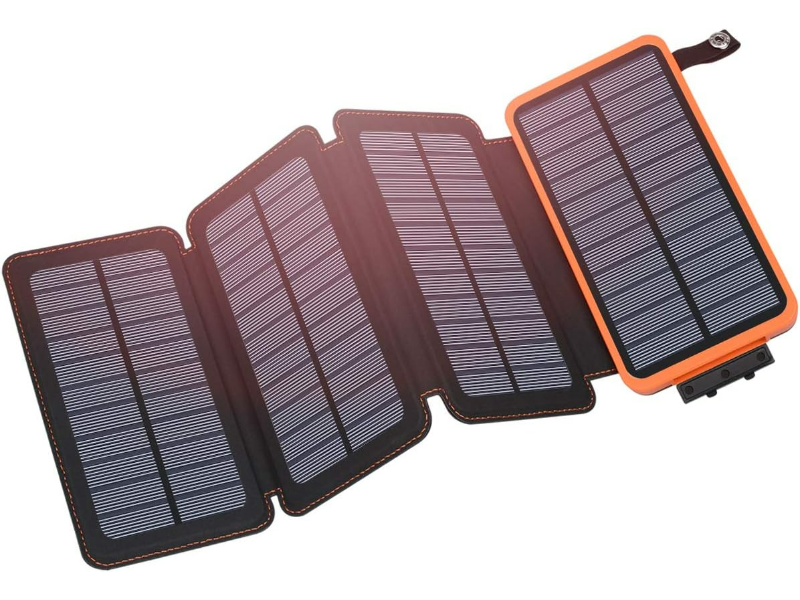
If you’re heading somewhere truly off-grid, the Hiluckey 25000mAh Solar Charger with four foldable panels is probably your best bet.
Pros
- Four solar panels mean faster charging in the sun
- Big 25000mAh battery—days of power for multiple devices
- Flashlight lasts up to 110 hours per charge
Cons
- Hefty at 1.21 pounds
- Solar charging is still slower than a wall outlet
- No built-in hook for hanging (despite what some photos suggest)
I took this Hiluckey on a week-long hiking trip, and it delivered when I needed it most. The four panels actually make a noticeable difference. Laying it out during breaks kept the battery topped up.
The battery is big enough to recharge my phone about seven times before I needed to plug the bank in again. I loved being able to charge my phone, headlamp, and a friend’s device all at once—no slowdown. At night, the flashlight was a lifesaver around camp and much brighter than my phone’s.
The orange case makes it easy to spot in your pack, and the rugged build withstood a few accidental drops. For anyone spending real time in remote spots, this one brings peace of mind.
Nuynix Solar Power Bank 49800mAh
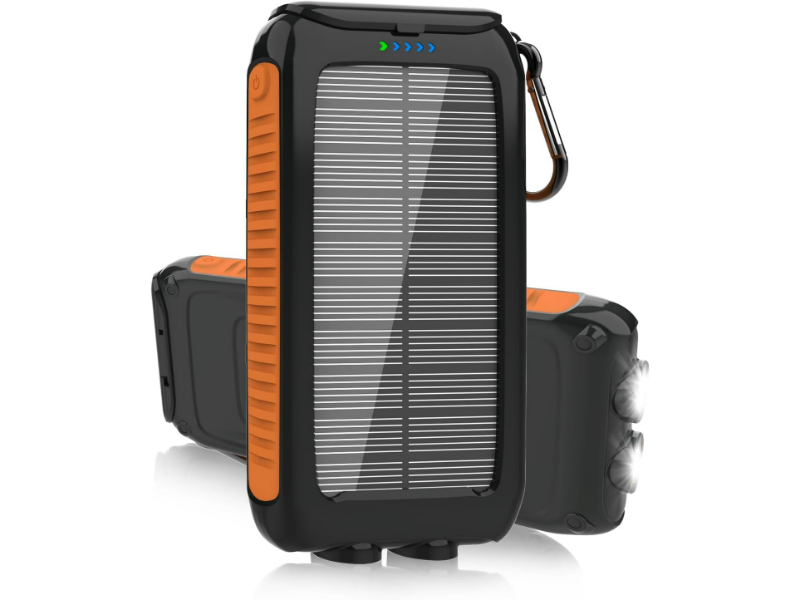
If you want serious backup power and the comfort of solar charging in emergencies, this Nuynix is a solid call.
Pros
- Fast charging—my phone hit 50% in about half an hour
- Triple device charging with multiple ports
- Rugged and waterproof, plus a built-in flashlight
Cons
- Heavier than most standard banks
- Solar charging is slow—backup only
- Orange color isn’t for everyone
I tested this Nuynix on a hiking weekend and honestly, it blew me away. The 49800mAh capacity isn’t just a marketing number—it truly lasts for days. Fast charging was a lifesaver at rest stops.
It feels solid and substantial, not like those cheap, flimsy banks. The IP67 waterproofing was handy when we got caught in a rainstorm. That orange color? Not subtle, but at least you won’t lose it in your pack.
Don’t expect the solar panel to refill the battery quickly—it’s really for emergency backup. I saw the indicator lights creep up after a few hours in full sun. The dual flashlights proved useful for setting up camp at dusk. If you’re heading off the grid, this one’s a confidence booster—no more dead devices when you need them.
Boogostore Solar Power Bank with Hand Crank
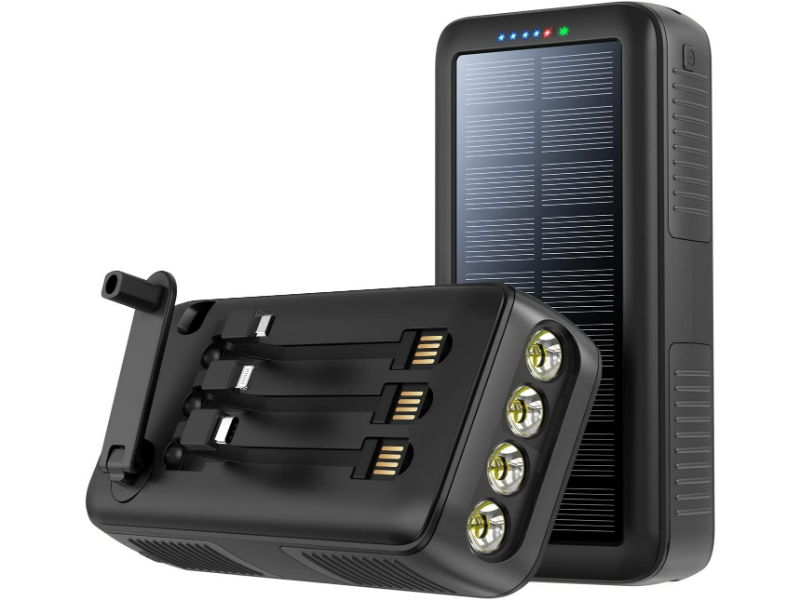
This portable solar charger brings a lot to the table for travelers. You get a massive capacity, a hand crank for emergencies, and a surprisingly useful built-in flashlight.
Pros
- Huge 63200mAh capacity—more than enough for several device charges
- Hand crank backup for those cloudy days when solar just isn’t cutting it
- Built-in LED flashlight with emergency SOS mode
Cons
- Too large to pass TSA in some countries
- Solar charging is slow (think emergency use only)
- Bulky compared to your average power bank
I brought this power bank along on a weekend camping trip, and honestly, it surprised me. That huge battery kept my phone, camera, and even my little Bluetooth speaker alive for the whole three days. Being able to rely on power security in the middle of nowhere? That’s a real comfort, especially when the build feels this tough.
The dual charging options make this one stand out. Sure, solar charging crawls along, but it’s a nice backup if you hang it from your pack while hiking. The hand crank, though—this was the feature I didn’t know I needed. When my phone was dead and I needed to call home, a few minutes of cranking got me enough juice to get through.
The flashlight ended up being a lifesaver at camp. Four LEDs, three lighting modes, and SOS—no need to pack a separate torch. At 1.5 pounds, it’s not exactly featherweight, but I’ll gladly carry it for the peace of mind. If your travels take you far from outlets, this is one of those rare items that earns its weight.
FMOOOSTORE 49800mAh Solar Power Bank
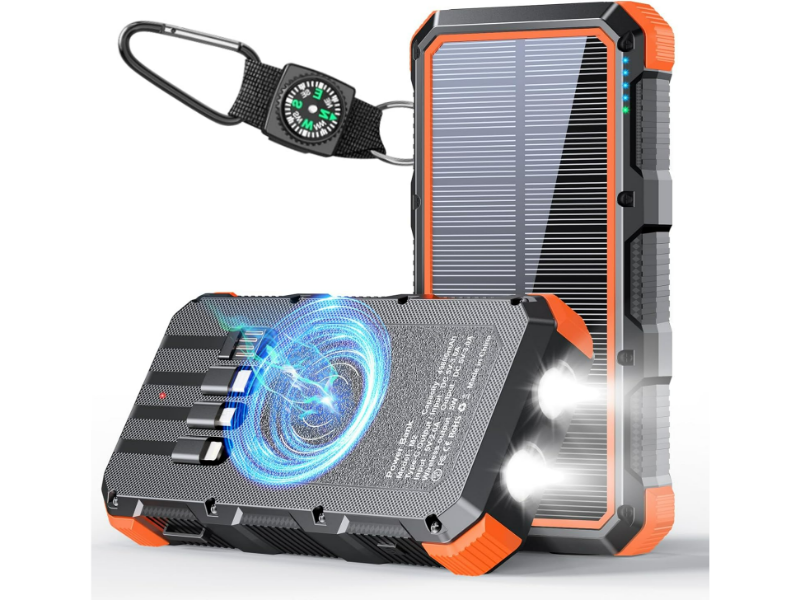
This rugged solar power bank is built for adventure. You get a wild amount of charging options and a shell that feels almost indestructible.
Pros
- Charge up to eight devices at once (yes, really)
- Silicone-protected corners for those inevitable drops
- Emergency flashlight with three modes
Cons
- Heavy at 1.26 pounds—definitely not ultralight
- Solar charging is slow (use as backup)
- Bulkier than most standard power banks
I took this one on a weekend camping trip and immediately noticed the bright orange color—it’s hard to lose. The silicone corners saved it when I dropped it unpacking my tent, and I felt like it could handle a lot worse.
Here’s the kicker: you can charge eight devices simultaneously. Built-in cables (USB-C, Lightning, Micro USB), regular USB ports, and even wireless charging. During my trip, I powered my phone, tablet, and a friend’s camera all at once without any hiccups.
That 49800mAh capacity? It’s legitimate. I got through the weekend with plenty left. The emergency flashlight’s three modes, especially SOS, proved surprisingly helpful when signaling friends after dark.
Solar charging is there, but you’ll want to juice it up at home first. The weight is noticeable, but for the sheer amount of power and durability, I’d say it’s a fair trade if you’re heading off the grid.
ERRBBIC Solar Power Bank
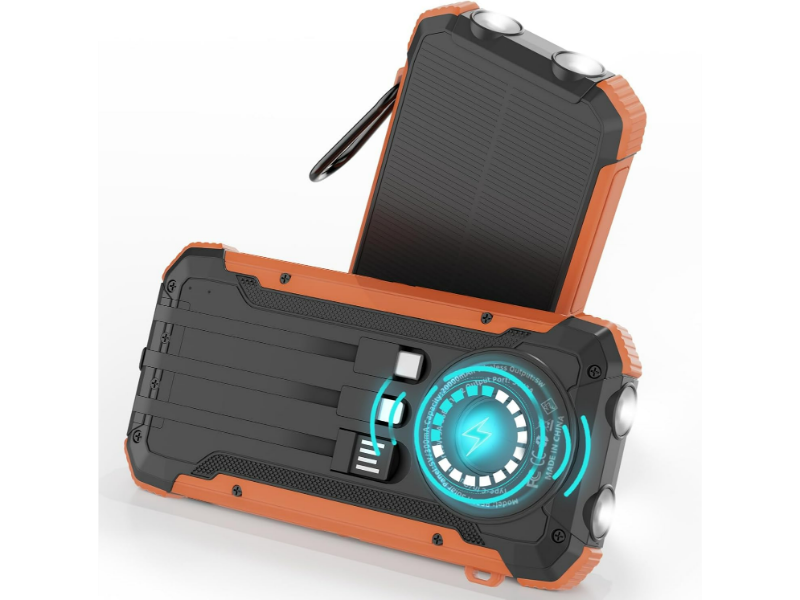
This 20000mAh solar power bank is a solid pick for travelers who need reliable charging off the beaten path. It’s tough, versatile, and loaded with practical features.
Pros
- Built-in cables for three device types, plus wireless charging
- Dual flashlight with emergency modes
- Seriously durable—waterproof and drop-proof
Cons
- Solar charging is slow (use it as backup)
- Slightly chunky compared to standard models
- The orange color is a bit much for some tastes
I took this ERRBBIC model on a week-long hiking trip last month, and it honestly changed the game. I didn’t need to pack extra cables for my iPhone or my friend’s Android—built-ins handled it all. Charging multiple devices at once felt seamless.
The 15W fast charging actually worked. My phone jumped from almost dead to 60% during a lunch break. The solar panel, as usual, isn’t meant for daily charging—think of it as a battery maintainer on sunny trails.
I dropped it onto rocks, and it didn’t flinch. The dual flashlight saved us when setting up camp late, and the carabiner clip made it easy to hang from my pack for a little extra solar boost. For anyone venturing far from power, this one’s a workhorse.
Buying Guide
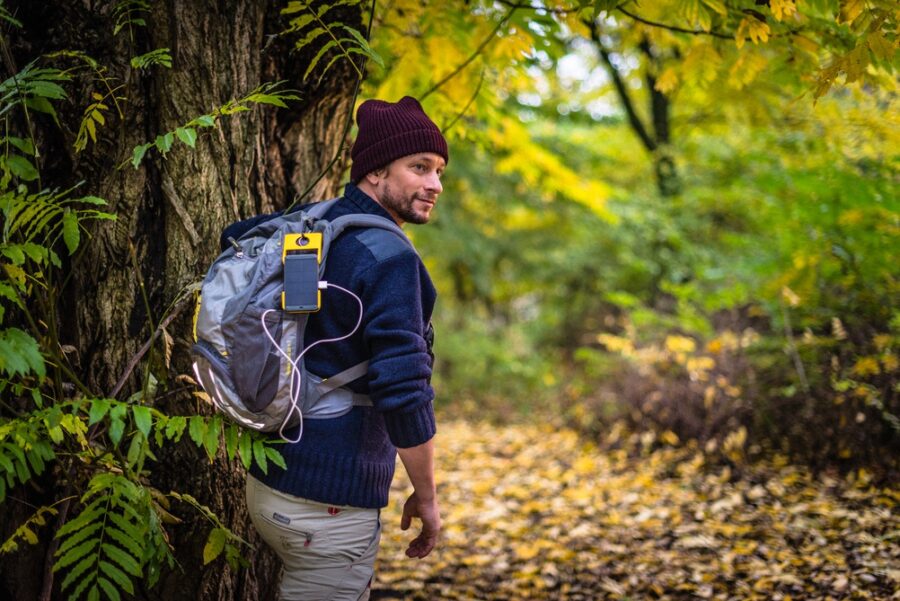
Picking the right solar power bank for travel isn’t as simple as grabbing the biggest one you see. After testing dozens of these in the field, I’ve realized a few features matter way more than others.
Capacity is king. Think about what you really need—are you charging a single phone, or are you running a phone, tablet, and camera every day? Most brands list capacity in mAh.
Here’s a quick cheat sheet:
- 5,000-10,000 mAh: One or two phone charges
- 10,000-20,000 mAh: Multiple phones or a tablet
- 20,000+ mAh: Multi-day trips or several devices
Solar Panel Efficiency often gets overlooked. Panels rated at least 5W are a must, but 7-10W is where you start to see real solar charging (not just a trickle).
Weight matters more than people admit. If you’re hiking, sometimes a lighter 10,000 mAh pack is better than hauling a 25,000 mAh brick.
Charging Ports need to match your gear. Most now offer:
- USB-A: Old reliable
- USB-C: Fast charging for newer devices
- Wireless: Convenient, but a bit slower
Weather Resistance is non-negotiable if you’re outdoors. Look for at least IPX4 (splash resistant), or IPX7 if you’re around water a lot.
Charging Speed varies wildly. Check the output numbers—higher is better for fast top-ups.
Don’t ignore Extra Features like built-in flashlights or SOS signals. They’re not just gimmicks—sometimes they’re the thing that saves your bacon.
Frequently Asked Questions
Travelers always have a few burning questions about solar power banks. Here’s a rundown of what I get asked most, plus some real-world perspective.
What are the top-rated solar power banks for extended camping trips?
For long camping trips, the Goal Zero Nomad 50 gets rave reviews from serious outdoor folks. It’s tough and delivers plenty of power for multi-day outings.
The EcoFlow River Pro with solar charging is another heavy hitter. Rugged, reliable, and capable of charging multiple devices over several days—what’s not to like?
If you’re a backpacker who counts every ounce, the BioLite SolarPanel 10+ is worth a look. Its integrated kickstand and battery make it a go-to for lightweight setups.
How do solar power banks perform under different weather conditions while traveling?
Most decent solar power banks shine in the sun, but things change fast when clouds roll in. The BigBlue 28W still manages 40-60% efficiency on overcast days, so it’s a solid year-round pick.
Rain and moisture can ruin some chargers. Models like the Anker PowerCore Solar 20000, with an IPX4 rating, handle wet weather much better.
Extreme heat? That’s a killer for charging speed. The RAVPower Solar Charger includes temperature regulation, so it keeps working even in the desert.
What are the key features to look for in a high-capacity solar power bank intended for travel?
Match the battery capacity (in mAh) to your needs. For longer trips, I like at least 20,000mAh—enough to charge a phone several times.
Multiple charging ports are a must if you’re carrying more than one device. The best models include both USB-A and USB-C, and at least one should support fast charging.
Durability counts. Water resistance, dust protection, and shock-proof builds help your power bank survive the rough stuff. Sometimes, military-grade drop protection is worth paying for.
Weight can make or break your experience. Try to find a model under 1 pound that still packs enough juice for your trip.
How do the charging speeds of the best solar power banks compare for travel use?
Solar input speeds vary a lot. Top-tier models convert sunlight at 5-7W in good conditions. Budget options might only do 2-3W, so expect longer charge times.
Output speeds are more predictable. Most quality banks offer standard 5V/2.4A USB-A, and newer ones add USB-C Power Delivery up to 18W for quick top-offs.
The Jackery SolarSaga stands out for its solar conversion—it charges devices almost twice as fast as bargain models when the sun is out.
Can I take a high-capacity solar power bank on a flight, and what are the regulations to be aware of?
Airlines let you bring power banks in your carry-on, but never in checked bags. TSA and international rules cap you at 100Wh (about 27,000mAh) unless you get special approval.
Always check the Watt-hour rating before you fly. Some power banks over 20,000mAh might cross the limit, depending on their voltage.
Protect the terminals to avoid short circuits. I use the original box or a dedicated case just to be safe—and to keep gate agents happy.
What are the benefits of using a solar power bank during travel compared to traditional power banks?
Honestly, the biggest perk is real independence from electrical outlets. If you’re hiking remote trails or winding up somewhere with sketchy electricity, solar charging just gives you that extra peace of mind.
You can keep your devices powered up as long as there’s sun. It’s hard to overstate how freeing that feels, especially when you’re out in the wild.
There’s also the environmental angle, which I think a lot of people overlook. Tapping into renewable solar energy actually shrinks your carbon footprint—kind of a nice bonus if you care about leaving those pristine places just as you found them.
Now, about the cost: sure, a solar power bank might cost more upfront. But if you travel often, you’ll notice you’re not shelling out for electricity or scrambling to find outlets at airports or hostels.
And let’s not forget emergencies. If you get caught in a blackout or some natural disaster throws a wrench in your plans, a solar power bank keeps on working—provided you can find some sunlight. That kind of reliability is hard to put a price on, isn’t it?



